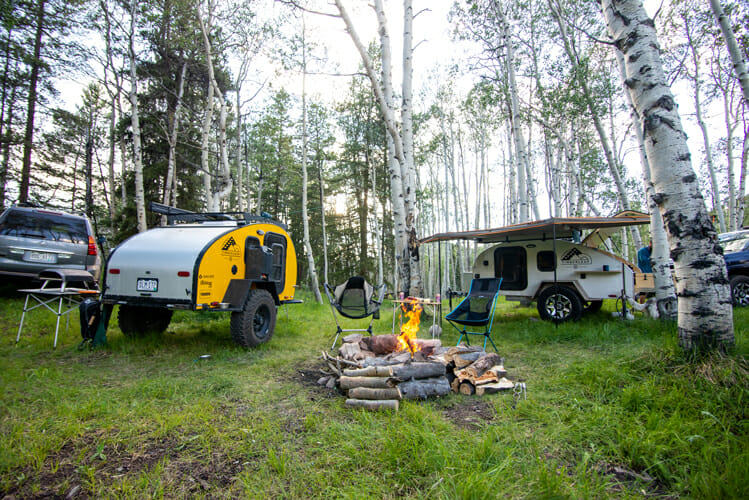
How to prepare for an overlanding trip
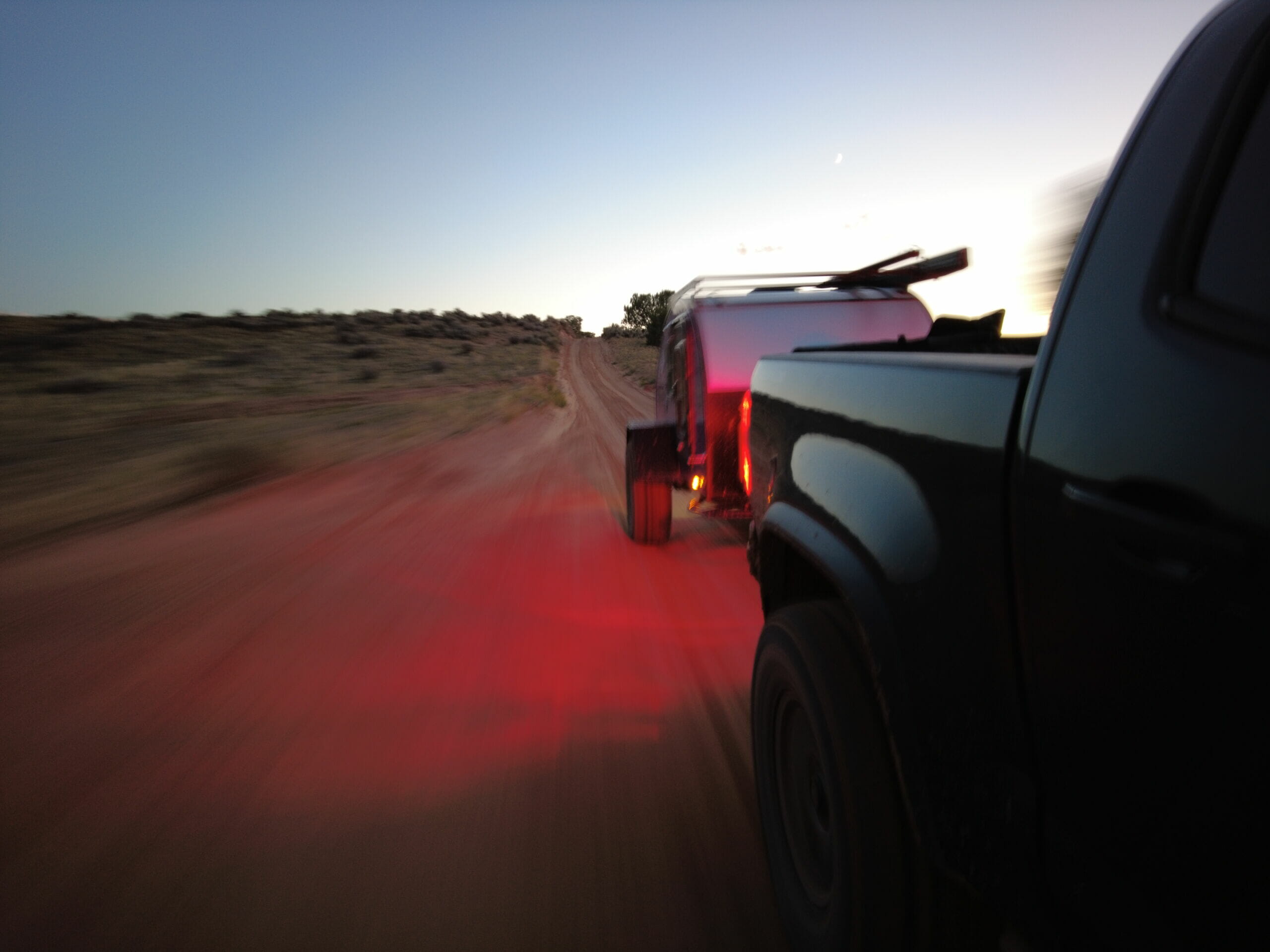
Preparing for a regular trip is easy – you figure out what you need to bring to get from point A to point B, and then determine what you’ll need once you arrive. Ski trip? Book plane tickets, bring a warm jacket and gloves. Beach vacation? Load up the car with beach chairs, sunscreen, and bathing suits.
But preparing for a trip where the journey is the destination can be a bit trickier. Overlanding offers the possibility for fantastic adventures, but it is possible for decision paralysis to set in as you realize the sheer amount of scenarios you may encounter while on the road.
This guide walks through the basics of preparing for an overlanding trip, from what to pack to vehicle and trailer prep. Keep reading to see what it takes to get ready for an adventure of a lifetime.
What is overlanding?
Overlanding can take many forms, but at its core it is embarking on a lengthy, self-reliant, journey through parts unknown.
- ‘Lengthy’ can vary – but it’s safe to say that the shortest excursions will last for several days, while longer overlanding expeditions may last weeks or months.
- ‘Self-reliant’ is a flexible term – you don’t necessarily have to set out with enough food, water, and gasoline to make it for the next 2 months – but if you’re staying in hotels every night it is safe to say you aren’t overlanding.
Overland adventurers may spend their nights camping, tucked into a teardrop trailer, or even in a roof top tent. Additionally, they’ll have food, water, fuel, and supplies enough to make it at least a few nights without resupply.
3. Finally, overlanding takes us through ‘parts unknown.’ These places will vary from person to person, as the parts of the country you’re familiar with will differ from those I’m familiar with. But, the goal of overlanding is to explore and discover new places.
Depending on who you ask there may be other answers to the question of what overlanding really means, but these three criteria will get us close!
Where can I go overlanding?
One of the best things about overlanding is the wealth of options available to overland travelers. The United States has literally hundreds of millions of acres of undeveloped lands that have been set aside for people to explore and travel through. Much of this land is overseen by the Bureau of Land Management (BLM) and the US Forest Service and offers a mind boggling number of options for overland adventures.
Outside of BLM and USFS lands, don’t count out national and state parks and even rural backcountry roads!
For those willing to practice their Spanish or brave the cold, North America offers nine additional countries to explore, from Canada to Panama. Getting past Panama into South America will involve the logistics of shipping your vehicle across the Darien Gap (only a few, extremely-determined individuals have ever crossed from Panama to Colombia by land), but this is not an insurmountable obstacle by any means!
However, even if we keep our focus closer to home, there are more overland trails in the US than most of us could ever hope to explore in a lifetime.

What should I pack for an overlanding trip?
Deciding what you need to pack for an overlanding trip is a balancing act. On the one hand, the more stuff you bring, the better prepared you will be for every possible eventuality. However, each additional gadget brings with it cost, weight, and space. Not only that, some items may start out useful and then wane in utility as hard-to-replace consumables are used up.
With that said, here is a basic list of overlanding essentials:
GPS Device –
Modern GPS devices are incredibly accurate and offer amazing capabilities, even far afield. Depending on your journey you may be able to use your cell phone’s GPS capabilities, but be aware that hot weather conditions can cause phones placed beneath your windshield to overheat while cold weather can quickly sap batteries. A dedicated GPS device, like those made by Garmin and others, is a sound investment for serious overlanders.
If your journey is going to take you off of paved roads be sure to download an app which will work for your region. Gaia GPS and onX Offroad offer the ability to download high quality offline topographic maps for navigation even when you don’t have network connections.
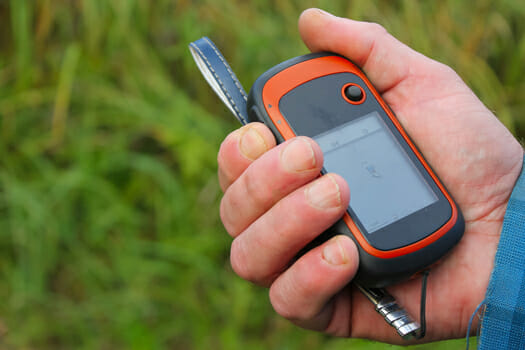
Paper Maps –
We live in a digital era and the days of road trips which were carefully plotted out along Rand McNally atlases are long behind most of us. However, if you will be spending any significant amount of time traversing small (often poorly maintained) roads a long way from civilization, you’ll quickly appreciate the simplicity of a paper map. There will be times where your GPS decides it doesn’t want to get a good fix on the sky, or your phone takes an unexpected swim in a mountain spring. In these moments you’ll be happy to have brought along a high-quality low-tech paper map!
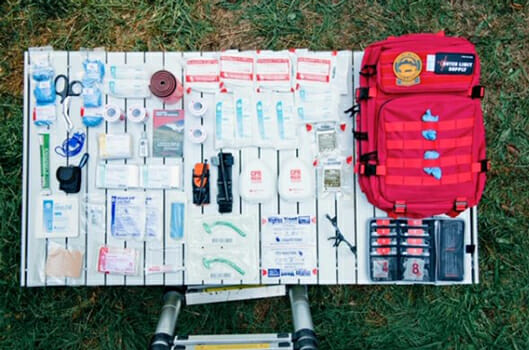
First Aid Kit –
Overlanding involves intentionally exploring beyond the safety net of civilization, places where you won’t find street lights, grocery stores, or pharmacies. As such, it is imperative that overlanders be prepared to fend for themselves should disaster strike.
This isn’t to say you need to be able to perform surgery in the field – but you need to be able to manage serious injuries well enough to get yourself out of the woods and back to the land of street lights and emergency rooms.
If you’re bringing along your four legged furry friends, consider picking up a dog-specific kit. These often include hydrogen peroxide to induce vomiting in case they eat something they shouldn’t have, in addition to some other dog related medical essentials.
Beyond handling emergencies, a good first aid kit will simply make your journey more enjoyable, allowing you to treat small scrapes, burns, stomach upsets, fevers, or other minor ailments that may crop up as you make your way through the wilderness.
Some great brands to look at are Outer Limit Supply, a Colorado-based company run by a first responder, Adventure Medical Kits, and MyMedic.
Air Compressor and Tire Plugs-
Whether it’s that gradually worsening vibration as you’re traveling down the highway, the gut-wrenching hiss of a tire striking a sharp rock, or just waking up to see your vehicle slouched down on an uninflated tire, flat tires are a great way to start a bad day.
But it doesn’t have to be that way! Many flats can be quickly and easily fixed with a couple tire plugs and an air compressor. For smaller vehicles you can skip the powered compressor and use a bicycle pump – but if you find yourself inflating a full-sized tire in the middle of a Louisiana summer afternoon you’ll be upset with yourself for that decision!
Flashlights / Headlamps –
Perhaps there is some perfect world where you could manage to avoid setting up or breaking camp in the dark, but the reality is you’ll inevitably find yourself engaged in complex tasks in pitch black. Cell phones have flashlights – but your thousand dollar iPhone is probably one of the worst flashlights on the market. Invest in a few durable LED flashlights and a headlamp per person. We’re big fans of Nebo flashlights which include USB charging which means you don’t need to bring along a set of spare batteries.
Headlamps are a game changer, making nighttime walks safer and more enjoyable. Don’t forget to pack extra batteries and if the flashlights have a travel-mode lockout that prevents them from turning on accidentally remember to engage it before packing them away!
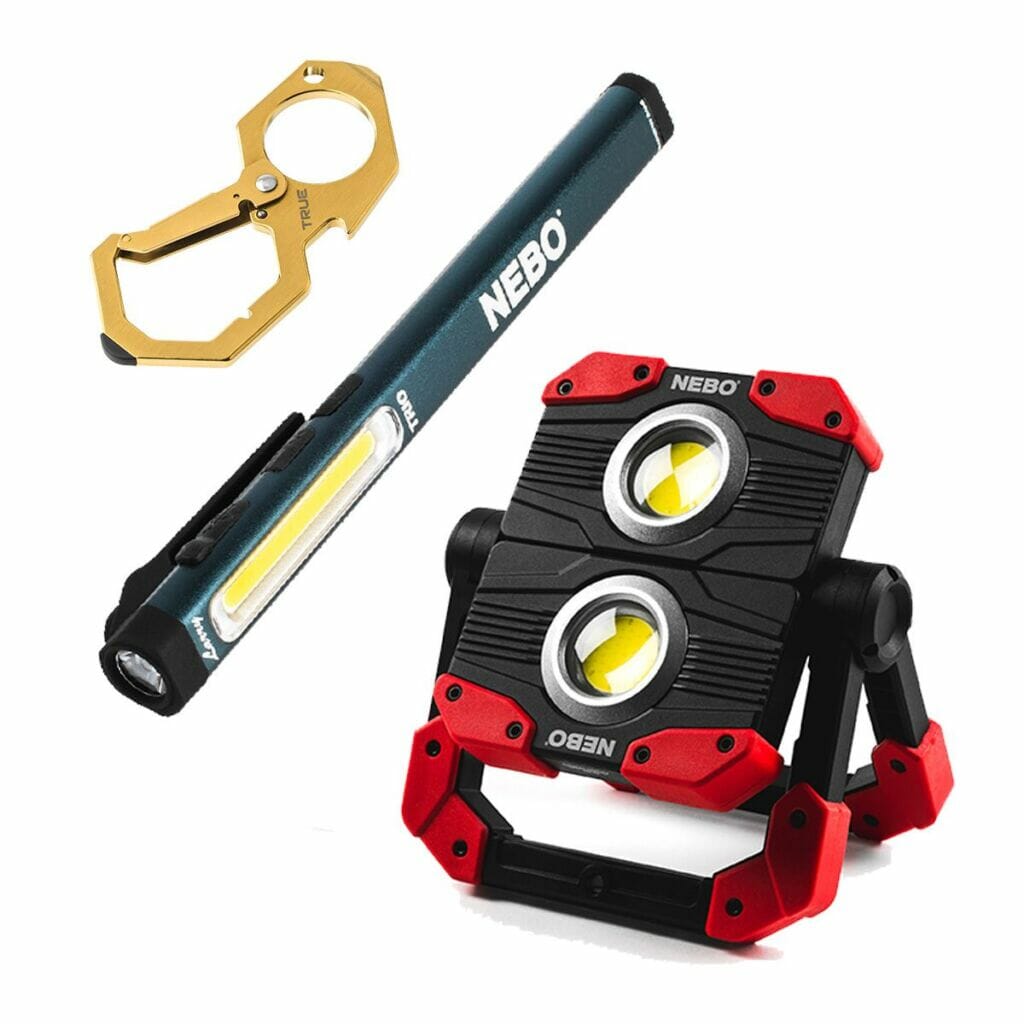
Camping Gear / Sleeping Bags –
This one should go without saying, but it’s so important we’ll say it anyway. While you can technically sleep in a car seat, you won’t enjoy the process! Instead, bring camping gear which is rated for conditions colder than you expect to encounter. Sleeping cold is exhausting and in extreme conditions can be dangerous.
Fire Extinguisher –
Fire is great when we want it – but can get out of hand. Bring along a fire extinguisher (or two) in case of emergencies. Keep one in your car and one in your trailer.
Tool Kit –
Even if you don’t consider yourself particularly handy, you’ll want to bring a basic toolkit. A knife, pliers, screw drivers, zip ties, and duct tape can go a long way towards solving problems. Your tool kit will vary based on the sort of gear you’re bringing (and thus will need to be able to repair), and your personal proficiency making repairs.
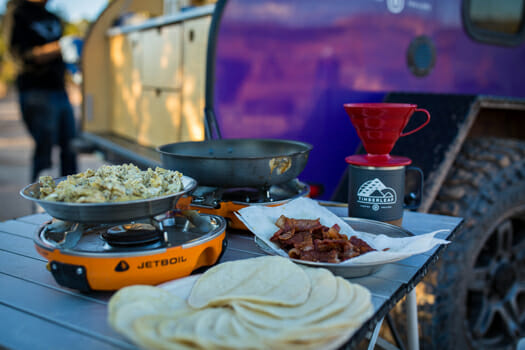
Extra Fuel, Food, and Water –
Running out of fuel, food, or water is bad news and overlanders would be wise to never allow themselves to do so. Plan ahead, keeping in mind that gas stations may be few and far between as you travel further afield. Depending on how aggressively you are pushing your limits you may be fine simply refilling your gas tank earlier than you would when driving around town at home. If you’re going to be making long distance pushes through back country wilderness then you’ll want to pack extra fuel.
Food and water are similarly important – always make sure to have more of both than you expect to need. In arid conditions water is particularly vital. Filters and iodine tablets are fantastic backups, but in a desert you may find yourself with nothing to purify. A jerry-can or two full of clean water is cheap insurance against disaster.
What kind of Vehicle preparation should I do for an overlanding trip?
When preparing for an overlanding trip you’re going to want to make sure all of your gear is in prime condition and ready to perform its best. This applies doubly so for your vehicle as a breakdown at an inopportune time could be expensive and time consuming at best!
The bare essentials include making sure that all of your vehicle’s vital fluids are clean and topped up. Change your oil, check your coolant levels, ditto for transmission and brake fluid! While you don’t need a brand new battery or fresh brake pads, make sure they have plenty of life left in them before you set out.
Certain vehicles will be easier to find parts for than others – a Toyota or American domestic manufacturer will be easy to get parts for even in the middle of nowhere. European imports or low-volume vehicles may be challenging to source parts for in a hurry – so take extra care to ensure that your vehicle is ready to go before you leave home.
Keep in mind that the conditions you will face may require non-standard fluid changes. Coolant and windshield wiper fluid are usually filled to specifications determined by region. The fluids appropriate for South Carolina will freeze at much higher temperatures than you could expect to encounter in Canada so you’ll need to plan ahead.
Speaking of cold weather, take a look at your tires and make sure that they are rated for the weather you’re expecting to encounter. Summer tires may work year-round in the sun belt but will offer little to no grip in cold weather. Some areas of the country will also require you to carry tire-chains in winter months.
Make sure that your tires have plenty of tread left – this includes your spare! Check your tire pressure and make sure you’ve set it to the correct PSI. It is commonly recommended to inflate your tires to a higher PSI if you’re going to be loading your car to its maximum weight. Check your owner’s manual or model-specific online forums for advice on inflation pressures.
If you’re planning on heading into remote areas with unpaved roads (or perhaps completely off road entirely!) then you’ll want to bring recovery gear. If your vehicle is equipped with a winch be sure that it operates smoothly. If you don’t have a winch, this is a worthwhile upgrade to consider and many off road vehicles like the Jeep Wrangler and Toyota Land Cruiser can easily have one retrofitted.
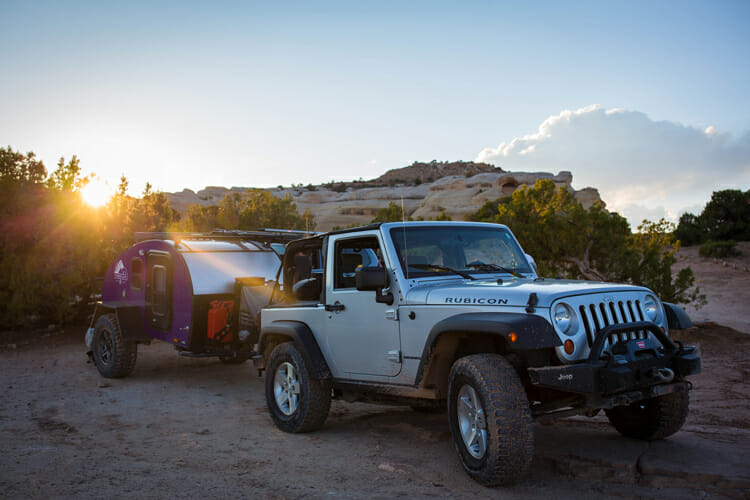
No winch? No problem! Pick up a come-along, tow straps, a set of tow hooks, and Maxtrax. Together these tools can accomplish the same tasks as a winch and are available at a much lower price. However, if you need to use them you may find that you pay back the money you saved in the form of physical labor.
Finally, check that all of your vehicle’s accessories are affixed securely. Roof racks need to be tightened occasionally, particularly if you’re planning on placing cargo on them.
How should I prepare my trailer for an overlanding trip?
If your overlanding trip is going to keep to the pavement, then most of your trailer preparation will mirror your vehicle prep. Check tire pressure, brake pads, and external hardware. Beyond these basics you’ll want to check that your trailer doesn’t exceed your tow vehicle’s weight limits (both tongue weight and total weight) when fully loaded with your gear.
However, if your trip doesn’t end when the pavement does, then you’ll want to take into consideration your trailer’s ground clearance, overall durability, and hitch articulation. Many trailers on the market give weight and price greater priority than off-road ability and this can lead to disaster on off road trails.
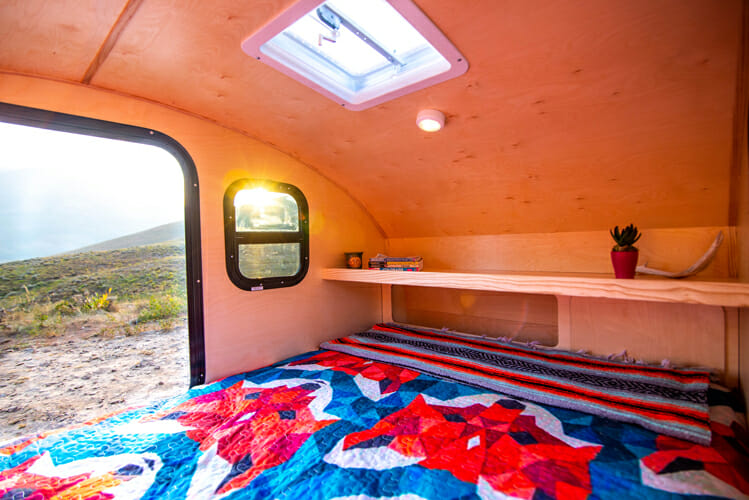
Timberleaf Trailers offer an off road package which takes the guesswork out of preparing for your next adventure. With up to 23” of ground clearance, 31” or 33” BFGoodrich KO2 off road tires (depending on trailer model), heavy-duty fully welded steel frame construction, integrated steel rock sliders, and our exclusive Max-Coupler Articulating Hitch for handling extreme angles of hitch articulation the Timberleaf Off Road package means your trailer is ready for whatever you can throw at it.
The best part is that all of this capability is paired with a full suite of comfort features like a built-in camp kitchen, a Colorado-queen sized mattress, and 1” of foam insulation to keep you comfortable even in extreme conditions.
Conclusion
To get the most out of your overlanding experience you need to be prepared. What preparation looks like will vary depending on whether you’re planning on tackling the road, trails, or going further afield.
At its most basic, all overland trips will require that you have shelter, food, water, and fuel enough to weather unforeseen setbacks. Further, you’ll want to bring maps, flashlights, first aid, and a basic tool kit to keep small problems from becoming big ones.
If you’re planning on heading off-road then your preparations will need to include recovery gear and you’ll need to be prepared for more serious problems as you’ll be further away from the helping hand of civilization.
Don’t forget to make sure that your trailer is making the journey too – a super capable four wheel drive rig pulling a flimsy trailer isn’t going to cut it when the going gets rough! Check out Timberleaf Trailer’s off road package to learn more about what makes Timberleaf trailers overland ready.
